How to achieve work-life balance
How to achieve work-life balance
Today, Millennials are approximately 22 to 37 years old, while those from Generation X are roughly 38 to 53 years old. With this age difference, many might expect priorities to differ when it comes to the workplace, but a recent Caddle survey reveals that the two generations actually share almost identical priorities at work. Both generations prioritize work-life balance first (31% Millennials, 30% Gen X), followed by respectful treatment (21% Millennials, 22% Gen X) and the opportunity to help others (15% Millennials, 13% Gen X).
If you aspire to achieve greater work-life balance, here are tips on steps you can take on both professional and personal fronts:

At work
At risk of getting an infamously catchy song stuck in your head, your key mantra should be to “let go.” Forbes recommends letting go of the pursuit of perfection, and proposes the idea that quantity over quality in the workplace may be better for the soul.
Both Forbes and Mayo Clinic encourage you to delegate more; Mayo Clinic further adds that you should say “no” more often – this will help you prioritize, manage your time more accurately, and therefore perform at a higher rate. Mayo Clinic also provides sage advice around email management: reduce email checkpoints to three times daily (late morning, early afternoon and late in the day) – this allows you to start your day by prioritizing your individual tasks and challenges, not those around you.
While it may seem counterintuitive, asking for help, delegation, and saying “no” are all signs of professional growth – these same habits that help achieve work-life balance are also milestones that your manager is likely looking for in your development.

In life
While it may be cliché, there is so much truth to the saying that “health is wealth.” While it may seem nearly impossible with everything going on at work, making time to exercise and eat healthfully are fundamental factors to achieving work-life balance.
Another important factor in improving personal health and professional performance is proper sleep. Harvard Business Review makes the case for getting quality z’s and provides tips on how to do so.
Whichever steps you choose to take toward a better work-life balance, remember to start small.
Survey Results
Valentines Day traditions and gifts
With Valentine’s Day around the corner, we’re in a romantic mood here at Caddle. We’ve been wondering what Canadians are up to on the big day, how they spend time and money with their partner, and whether they had plans to celebrate this day of love.
Valentine’s Day traditions
When it came time to decide how to spend Valentine’s Day 2019, responses were split in a recent Caddle survey; while 25% looked forward to buying presents for their significant other, 21% said they and their honey don’t celebrate Valentine’s Day. Treating their significant other to an experience and being unsure if they will celebrate were tied for third at 19%, while not celebrating at all trailed in fourth place at 15%.
Who is Saint Valentine?
St. Valentine is the patron saint of lovers, epileptics, and beekeepers. By some accounts, he suffered martyrdom during the persecutions of Christians by emperor Claudius II Gothicus circa 270. According to legend, he had signed a letter “from your Valentine” to his jailer’s daughter (who became a friend) and healed her from blindness. Another common legend states that he defied the emperor’s orders and secretly married couples to spare the husbands from war. – Source: Britannica.com
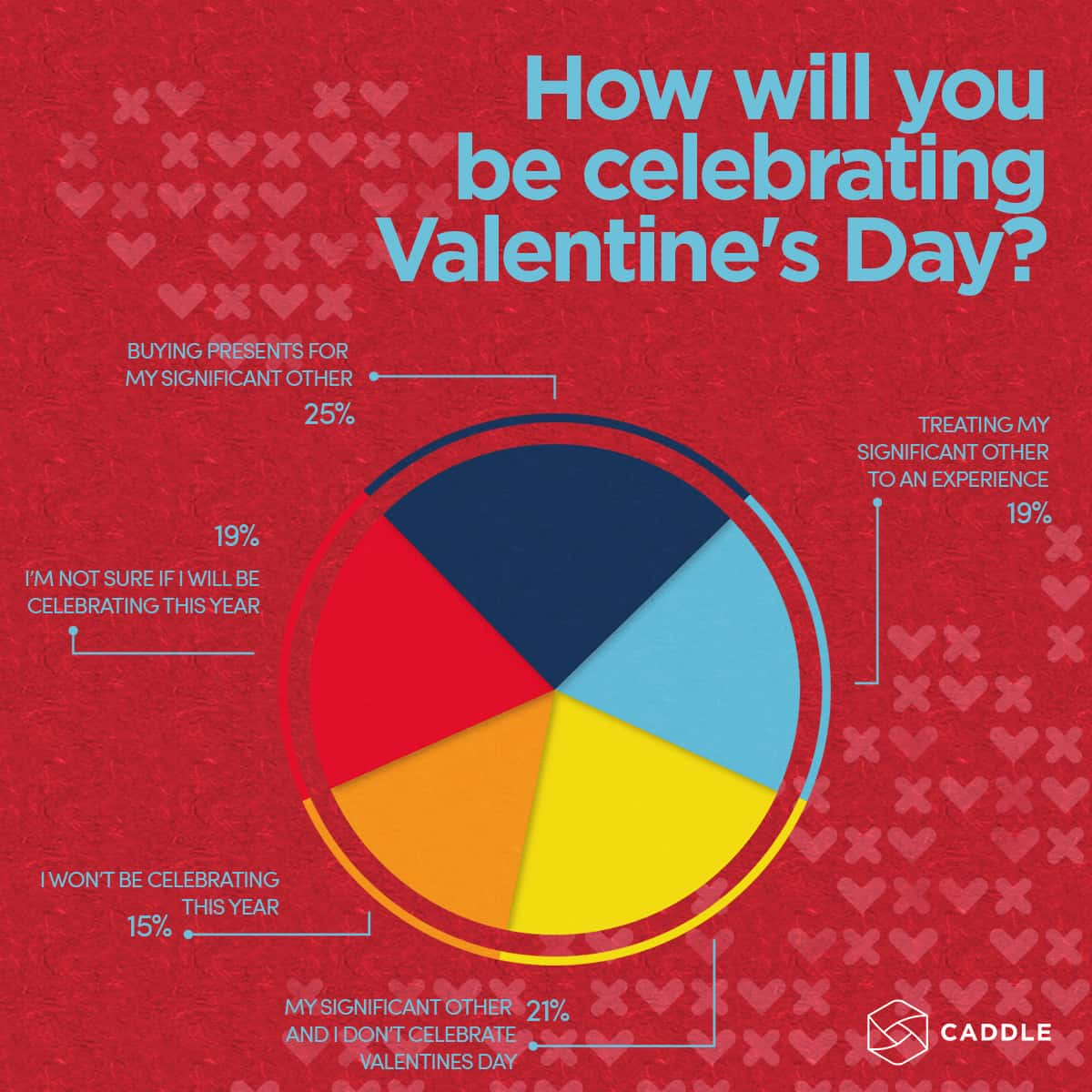
Valentine’s Day gifts
Asked what they think the best way to celebrate Valentine’s Day is, respondents know what they like. Spending time with their significant other was the clear winner at 49%, while “doing something special/being treated to an experience” trailed in a distant second at 22%. Not celebrating Valentine’s Day (10%), “a simple card is good enough for me” (7%), “being showered with gifts” (5%), “gifts, cards, and a special experience” and “Other” ( tied at 3%) rounded out the answers.
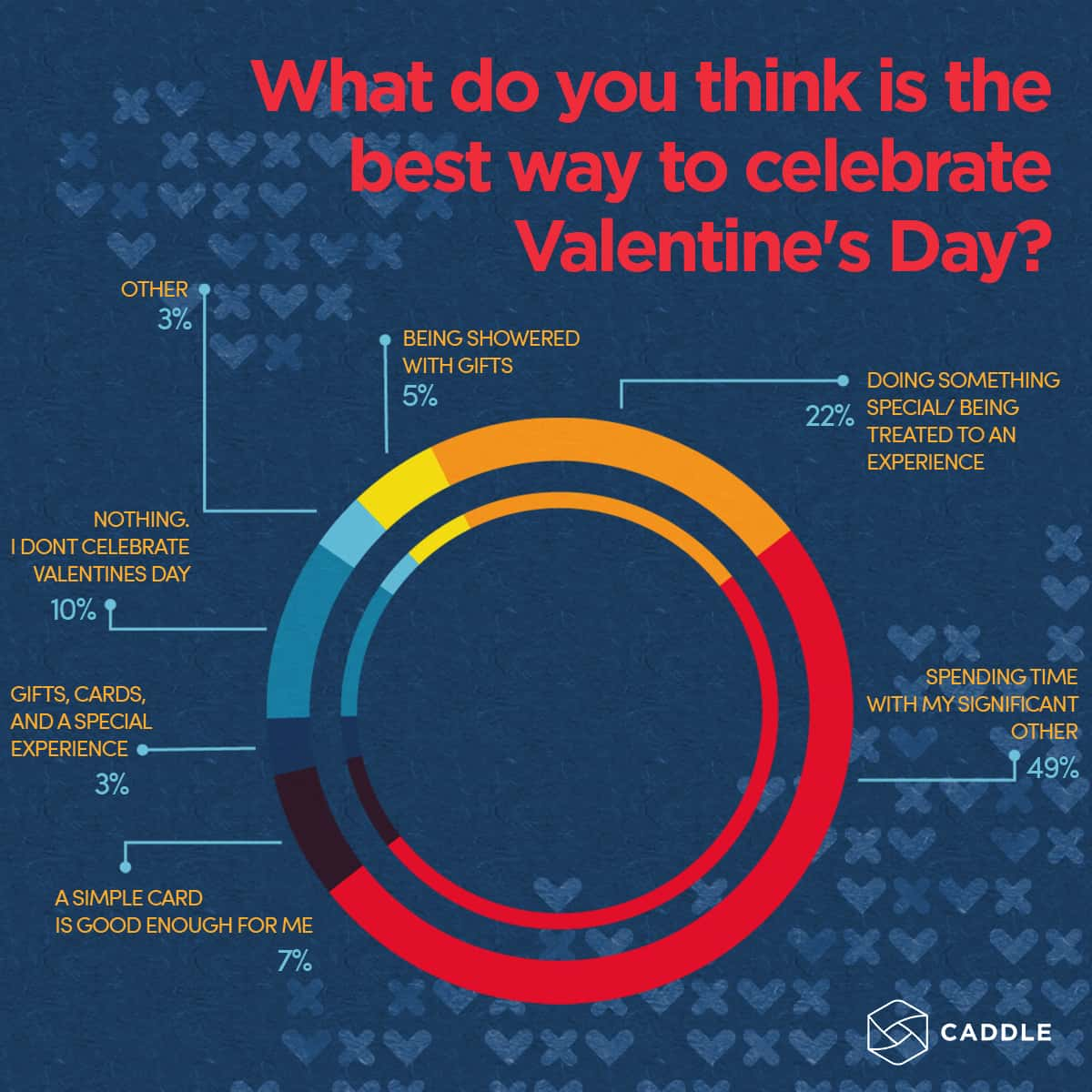
How much to spend on Valentine’s Day?
Once you’ve chosen how you’d like to spend your time and money making memories with the one you love, you’ve got to decide how much to spend. Respondents to this survey are conservative spenders when it comes to Valentine’s Day, with 36% saying one person should spend less than $20. Spending in the $21 to $50 range fell closely behind at 35%, while 16% came in a distant third with a range of $51 to $100. Eight percent fell into the “Other” category, while 5% said $101 to $200, and 1% would go all out at $201 to $500. No respondents said they would spend more than $500.
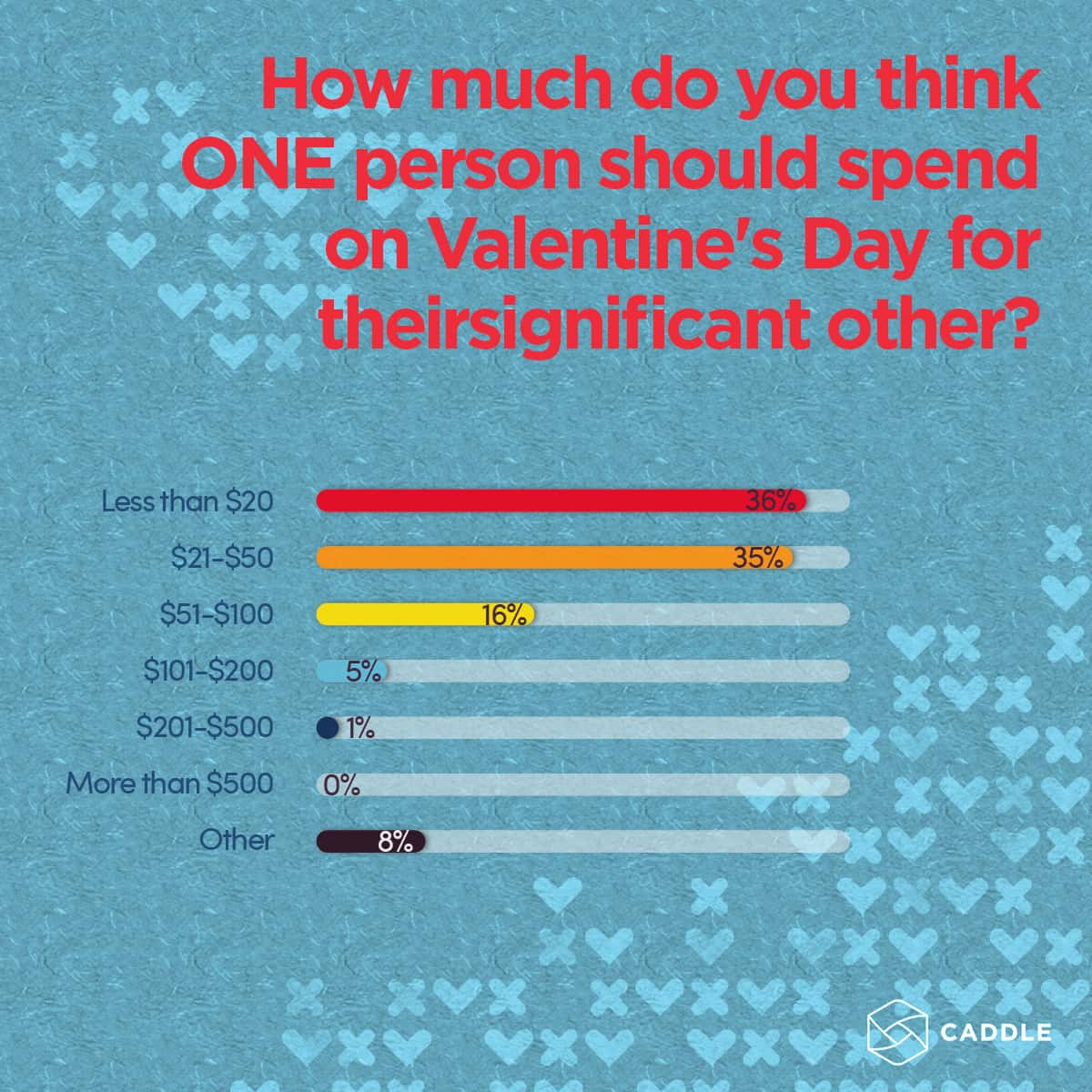
Gifts infused with meaning always win hearts, and our respondents were no different; 29% said the best Valentine’s Day gifts are “something that means something to me”, while 21% would like to be surprised with something they want but probably wouldn’t buy for themselves and 14% were more pragmatic, preferring “something practical.” Following behind were the 13% who don’t do gifts on Valentine’s Day. Traditionalists who prefer flowers or chocolates and “something simple and sweet like a card” tied for fifth place at 11%.
Did you know?
Richard Cadbury, a scion of the Cadburys, a British chocolate manufacturing family, started the tradition of giving a box of candy in the 19th century. The company had recently established a new technique to create more varieties of chocolate, and Cadbury pounced on the opportunity to sell the chocolates as part of the beloved holiday. – Source: History.com
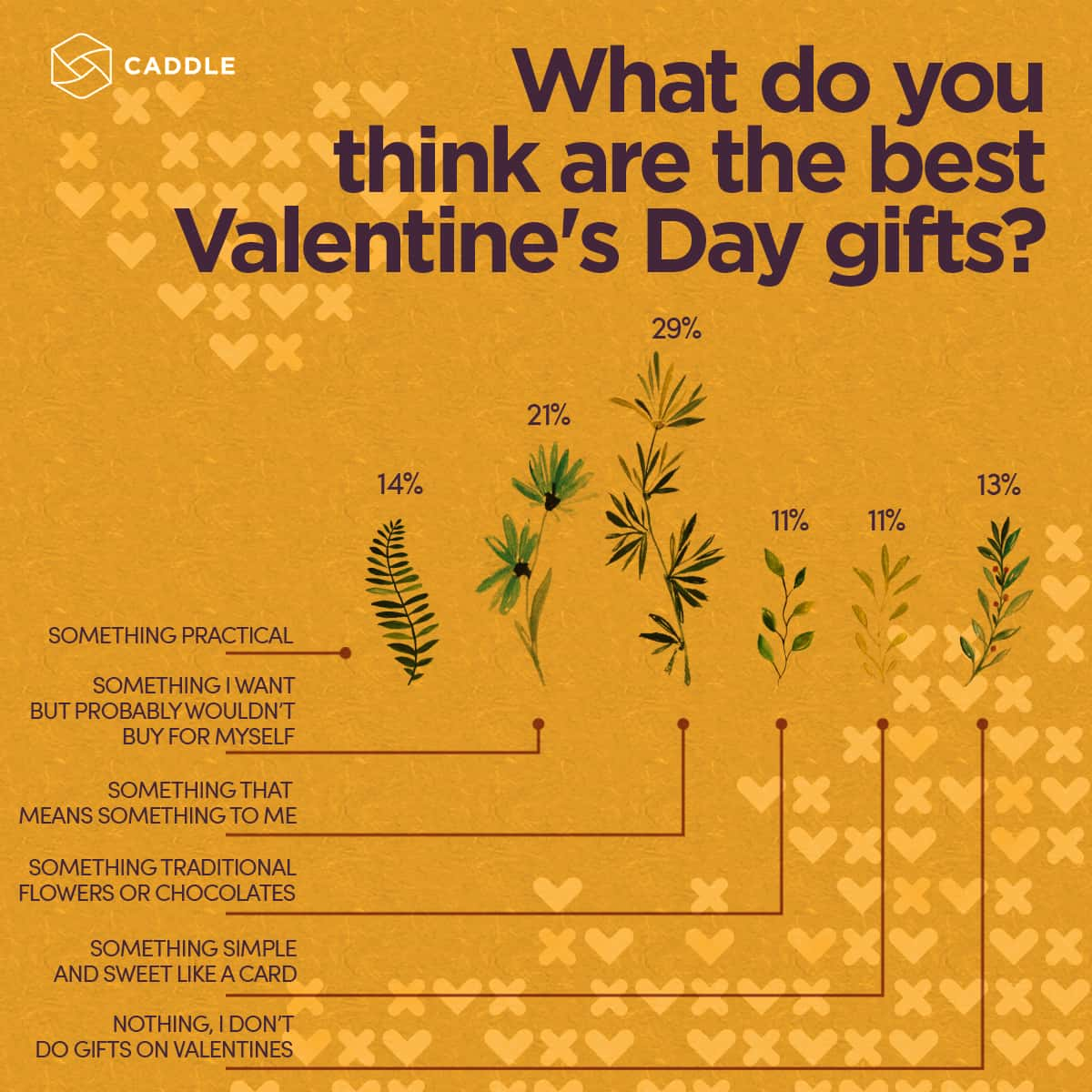
Valentine’s Day Experiences
If you lean more towards experiences, you’ve got lots of options, from meals to a night on the town or even scratching an item off your bucket list. Asked what they think the best Valentine’s Day gifts/experiences are, 35% want “a nice meal together”. The rest of the answers were distant favourites, with 14% looking to book “some alone time without the kids” and 11% wanting “a night with the family”. “A unique night out” and “a meal cooked together” tied for fourth place at 9%. Eight percent don’t do anything for
Valentine’s Day, 6% would love “a night away”, and 4% were in the “Other” category. A “wine tasting/tour” and “something off our bucket list” tied for last place at 2%.

Whether you spend Valentine’s Day with your sweetheart on the town, having a quiet meal in, or surprising them with a gift or experience to brighten their day, what’s really important is expressing how much you mean to each other.
You can create an amazing Valentine’s Day for you and your flame by putting your Caddle cash towards a special gift or crafting an evening just for the two of you. If you’re single, why not take the day for some well-deserved self-care? Start creating your own Valentine’s day traditions today.
Read More: Our Career Survey revealed Canadians want more than just a pay cheque at work.
Careers Survey Results:
Canadian's Want More Than A Pay Cheque at Work
In late August 2018, Caddle surveyed 10,000 Canadians on their careers, job seeking, the importance and impact of workplace culture, and more.

Full-time employment still most popular
When it came to employment status, full-time (54%) still outstripped part-time by far (13%) and self-employed (6%), although 10% were homemakers and 5% were retired. Among the unemployed, 4% were looking for work. People not employed and not looking for work and students tied at 3%.
In a traditional workplace setting, your title might factor into both the type of work you do and your experience overall. 31% of respondents reported they were Intermediate level, followed closely by those who didn’t categorize their title (29%). Entry level and Middle Management each came in at 15%, while Executive and Upper Management employees rounded out the bunch, each coming in at 5%.
Curiously, 23% of people didn’t name their industry, while 14% were in health care and social assistance. Educational services came in a distant third, while educational services and other (except public administration) followed at 9% and 8%, respectively.

What keeps employees happy?
Because we spend so much of our lives at work, it’s important to be happy with our jobs, and for these respondents it takes more than a pay cheque to make that happen. In fact, “I just want a pay cheque” did not even crack the top five, but “work-life balance” took first place by far at 30%, followed by “being treated with respect” at 22%. “The opportunity to help others”, “having variety and change at work” and “having my work recognized” took up the last three spots in the top five at 22%, 14% and 8% respectively.
How important is workplace culture?
We often hear about how important workplace culture is – it can affect everything from your interactions with leadership and coworkers to ever-critical work-life balance and the company’s ability to recruit new employees. 91% of respondents said workplace culture was “moderately important”, “somewhat important” or “extremely important” both to their professional success and personal happiness.
Not unsurprisingly, salary still attracted these employees to their current positions, with 22% saying the main reason they accepted their current job was because it offered a “better salary than (a) previous role.” For 16%, it was a “unique work opportunity”, while 13% “simply needed a job.”

What perks and policies do employees value?
If you plan on staying in your position for the long-term, perks and policies become more important as your lifestyle and needs change throughout your time with a company. When it comes to which are most important to respondents, “Flexible hours” was the clear favorite at 29%, while “happy/friendly coworkers” came in at a distant second with 13%. “Work from home policy” netted 12%, while 11% picked “personalized benefits” and 10% were easily pleased – they just wanted a job they didn’t hate.
Are employees applying elsewhere?
If curiosity has ever gotten the best of you, you’re not alone. In fact, 52% of respondents believe it’s “completely acceptable” or “somewhat” acceptable” to apply to other jobs even if you have no intention of leaving your current job. They were split about whether it was okay to attend a job interview if you don’t have any intention of leaving your current job; 30% believed it was “not at all acceptable”, while 28% believed it was “somewhat acceptable.”
Loyalty
How restaurants are building relationships
In his classic Kitchen Confidential, the late, great Anthony Bourdain famously revealed that the best day to eat out is Tuesday – for three key reasons:
- The best chefs are off duty on Monday, return rested and ready to go on Tuesday.
- Fresh ingredients are typically delivered to restaurants on Tuesday (also Thursday and Saturday).
- Chefs prefer to cook for weekday guests than weekenders, because weekday guests are the true regulars – weekends typically track in tourists.
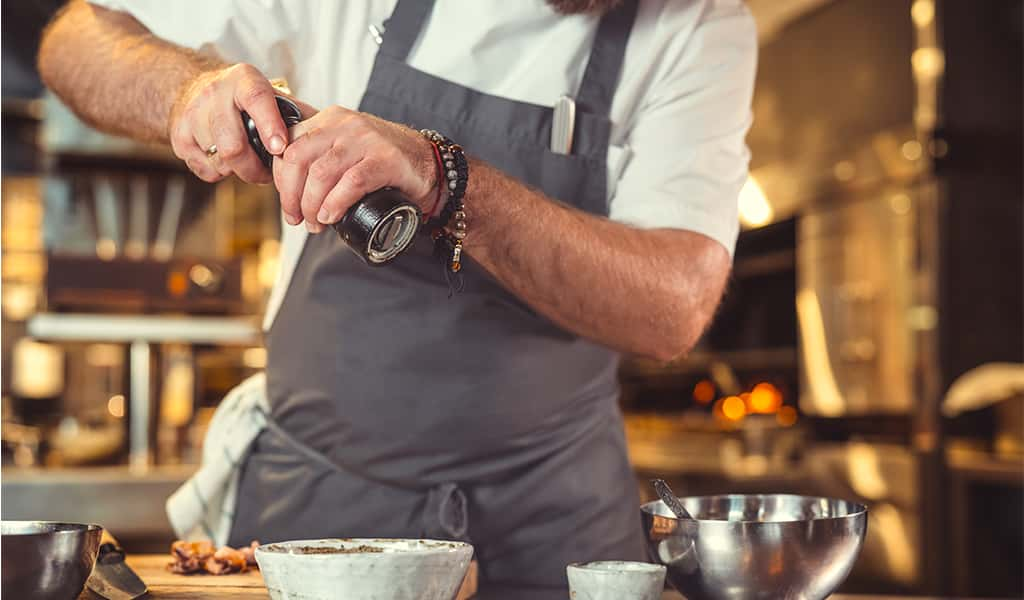
Restaurant Logic reinforces the importance of prioritizing regulars: they provide stable income, will champion you and recommend your restaurant to others, and are more willing to provide honest, helpful feedback to you, because they know you.
In a recent Caddle survey, 60% of respondents see loyalty and rewards programs as an important factor in their dining decision. Quality food and quality service are always important factors when it comes to food, but a loyalty program can seal the deal and help build your relationships with regulars.
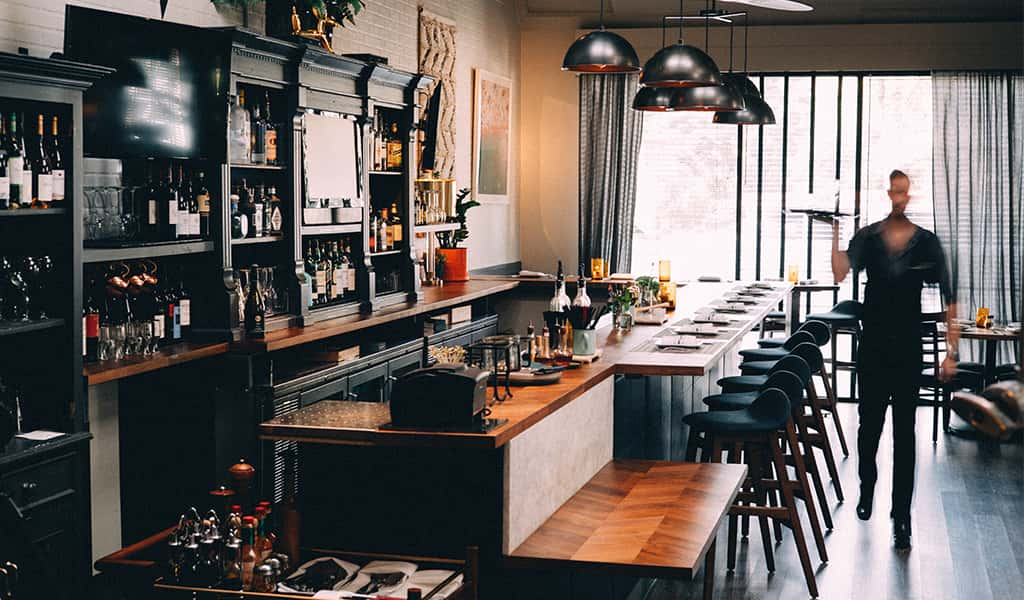
Clutch reports that loyalty members have a 26% higher annual spend, 10% increase in purchase frequency, 15% higher average order value, and 25% higher engagement versus non-members. Upserve states that 82% of loyalty members refer at least one person and spend an average of $2.14 more than non-members, which is vital in the quick service restaurant industry.
Upserve recommends offering a VIP experience to loyalty members, while Webstaurant Store suggests offering incentives such as a chance to win a free meal or gift certificate, to consider loyalty programs that integrate with your Point of Sale system, and to utilize the program to improve traffic during quieter periods throughout the week. Finally, Webstaurant recommends to make sure your rewards program is attainable, favourable, and above all else – simple.
Dollars for data
How researchers are rewarding users
The products and services we use every day are made increasingly better by the data we provide marketers, brands, and researchers. But do we deserve more?
In today’s world, everything from your puppy portraits to the route your ride share driver takes are being tracked. Sporting a step counter, pre-ordering your pumpkin spice latte on-the-go, even the sultry sounds you select on Spotify – in almost every aspect of our daily lives, meaningful data is being collected and influencing the future products and services sold back to us.

The data we provide [ideally] result in more accurate, tailored solutions provided back, but should we be rewarded further for the data we’re providing? When Caddle users were asked this, 89% said “of course!” The research and reward model is one that Caddle has helped pioneer and polish in Canada, and thanks to peers following a similar model, the world is becoming fairer for users sharing tidbits of their preferences online.
Here at Caddle, we employ a simple and effective cashback model: businesses pay to feature ads and ask questions to our users, our users collect cash for watching ads and answering questions, and we earn a small amount in handling the overall transaction and providing an easy-to-use platform. The benefits of our solution are immediate: businesses pay for ads that actually get attention, and users are rewarded for their valuable time and data.

Other Canadian companies have embraced this collegial approach to data, too. Carrot Rewards focuses on wellness, integrating with fitness apps like Fitbit and then rewarding users for steps via existing loyalty programs such as Aeroplan, Petro Canada Petro Points and Cineplex Scene. Along the way, users have the opportunity to earn more rewards via surveys (commissioned by external partners), not dissimilar to Caddle.
Peer-to-peer goods trading network Bunz recently embraced both cryptocurrency and the research/reward model with the release of BTZ (pronounced like “bits”), a currency that Bunz users can use in trades or at local businesses who accept it for payment. Users can further earn BTZ by answering single-question surveys from Bunz each day.

Whether or not global social media giants like Facebook and Instagram will adopt similar reward-focused research models remains to be seen, but as publications like The New York Times and The Economist are poised to help challenge the digital world, we’ll keep doing our part.
Social media sites and why it's hard to leave
Earlier this year, Caddle surveyed users on their relationships with social media and awareness of the Facebook and Cambridge Analytica scandal. Not surprisingly, Facebook remains the most-used platform among users from Boomers (64%) to Generation X (64%) to Millennials (59%), while Gen Z users are favouring Instagram at 36% versus Facebook at 23%.

In March, USA Today reported the trend of users parting from Facebook and prioritizing Instagram for social networking. Citing Pew Research Centre, USA Today highlighted that “…800 million people log in to Instagram at least once a month, 500 million of them every day… 35% of US adults use Instagram, an increase of 7% from 2016.” This comes as no surprise to TechCrunch editor Josh Constine, who explains that, “Every social network has a half-life. Eventually parents get on it, grandparents get on it, your boss gets on it. And you don’t want to hang out with them.”
…800 million people log in to Instagram at least once a month, 500 million of them every day… 35% of US adults use Instagram, an increase of 7% from 2016.

And yet, with the dominance of Facebook and the rise of its subsidiary Instagram, many Instagram users are unaware of the connection and their privacy risks with the revelation of the Cambridge Analytica scandal. CBS News reported in April that almost 57% of Americans do not know that Facebook owns Instagram. The lack of representation regarding this relationship is purely intentional, too – to this day, there are no evident branding ties between Facebook and Instagram platforms, nor Facebook’s other biggest subsidiaries such as WhatsApp and Oculus VR. This may change with the recent exit of top Instagram executives Kevin Systrom and Mike Krieger following a contentious year between Instagram and Facebook; The Verge is predicting “the end of Instagram as we know it.”

If you’re an avid Instagram user and think you may be affected by the Facebook security breach, Tech Crunch provides a thorough guide on what to know and what to do next.
Cannabis stigma - is there a change on the way?
is there a change on the way?
In a Caddle survey of approximately 10,000 Canadian non-cannabis users earlier this year, our team found that 77% of respondents had no intention of trying cannabis once legalized in Canada. When asked about potential reasons why they might potentially try cannabis, 49% of respondents maintained that they simply would never try it. 43% were against legalization of recreational cannabis in Canada, 53% either disagreed or strongly disagreed that legalization would be good for society, and 54% of respondents felt there is a negative stigma still associated with cannabis use.

What are the stigmas?
Last year, the Government of Canada commissioned an official Canadian cannabis survey, including both users and non-users from 16 years and up. In the survey of 9,215 Canadians, 77% of respondents felt that cannabis could be habit forming, and while nearly half indicated positive effects on mood, anxiety, sleep and creativity, the majority of respondents felt that cannabis can negatively affect motivation (57%), memory (58%), concentration (59%), attention (60%) and decision making (62%). Interestingly, while alcohol was widely considered the most socially acceptable substance, more respondents felt cannabis was socially acceptable (28%) than tobacco (19%).
Is legalization driving the stoner stereotype away?
In a 2017 study performed by U.S.-based cannabis research firm BDS Analytics, the researchers found that the average household income among Californian consumers is $93,800 compared to $74,350 for non-users. Californian users are more likely to hold master’s degrees, and Colorado users are more likely to be employed full-time compared to non-users. In the same study, BDS Analytics found that users from California and Colorado (two of the nine United States where cannabis is currently legal) are more likely to consider themselves very social, and are more likely to enjoy the outdoors and volunteer their time compared to non-users from the same states.

How will the stigma turn a corner?
For the non-users surveyed by Caddle, the leading reasons why they might try recreational cannabis once legalized included pain relief and relaxation (14%), curiosity (12%), and reduced stress and anxiety (10%). Wellness is a constant reason for interest and usage according to most research available so far. In a report by Deloitte, the top two reasons for using recreational cannabis include relaxation and sleep (66%), and to reduce stress or anxiety (62%).
Read more from the Caddle Cannabis Survey
Canadian identity: Seven similarities of the common Canadian
Although known for embracing the many cultures that make up Canada’s mosaic, it appears our multicultural population share more in common than one might expect. In a recent Caddle survey, 70% of respondents felt they have much in common with Canadians from other provinces – and here are seven of the many traits we share:
1. Frenzied fans of hockey
Invented in Canada, hockey is our official national sport. Canadian-born players continue to make up the majority of the National Hockey League at 41.6%, and our national teams have dominated on the international stage for generations.

2. Notoriously nice
If there are common characteristics non-Canadians cite of Canadians, it’s that we’re warm, welcoming, and polite – if not to a fault. In fact, without exaggeration, we’re likely to apologize even if you’re the one truly at fault. Sorry about that.
3. Hankerin’ for Hortons
Truly ubiquitous, Tim Hortons is the largest fast food restaurant and most popular coffee in Canada. Even the most hard-hearted coffee hipster will concede that Tims/Timmies coffee is iconic, beloved across the country, and a definite road trip staple.
4. Cottage country crazy
Home of approximately 60% of the world’s lakes, it’s no surprise that Canadians prefer to spend summer weekends at the lake.
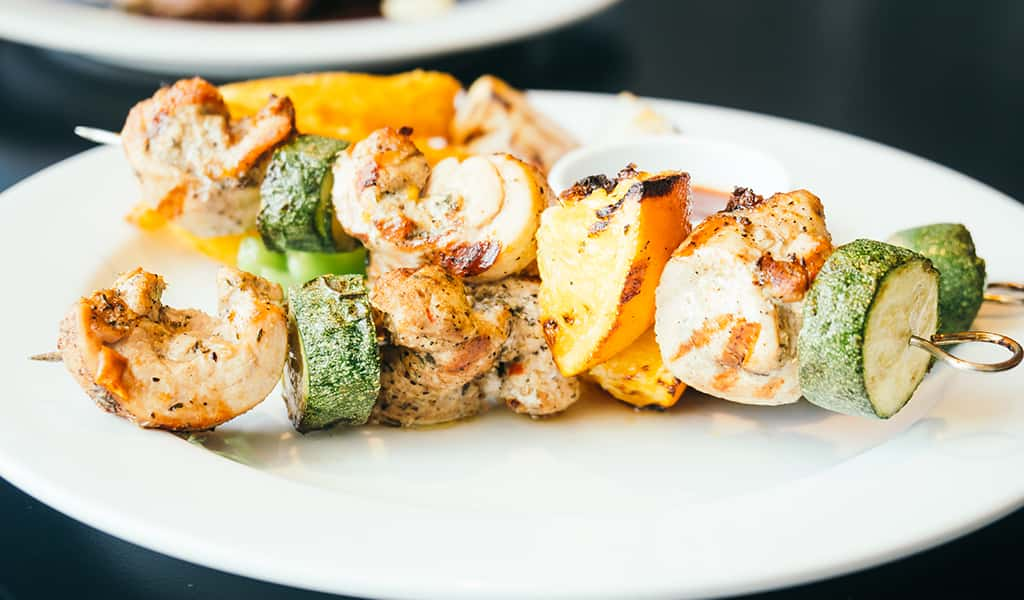
5. Comedic claim to fame
From Catherine O’Hara to Eugene Levy, Jim Carrey to Mike Myers, Michael Cera to Seth Rogan – Canada is a historic hotbed for comedic talent.
6. Desired differentiation
If there’s one not-so-nice quality many Canadians share, it’s an almost passive-aggressive need to be known as distinctly not American – especially in our travels abroad.
7. Eh B C’s
For a word so short, there’s no shortage of its use. We often do not realize how much we say “eh” until we step foot in another English-speaking country where it’s not commonly used. Go figure, eh?
Restaurants dining for Canadian food
In 2017, Dalhousie University conducted a survey of 1,019 Canadians regarding their dining habits – how often they dine out, get take-out or delivery, dine alone or with others, and whether they cook at home. 42% of respondents claimed to buy ready-to-eat meals or dine at a restaurant once or twice a week, and 3% admitted to doing so daily. Experts concluded that the top reason for dining out so regularly is a lack of time to prepare meals at home.
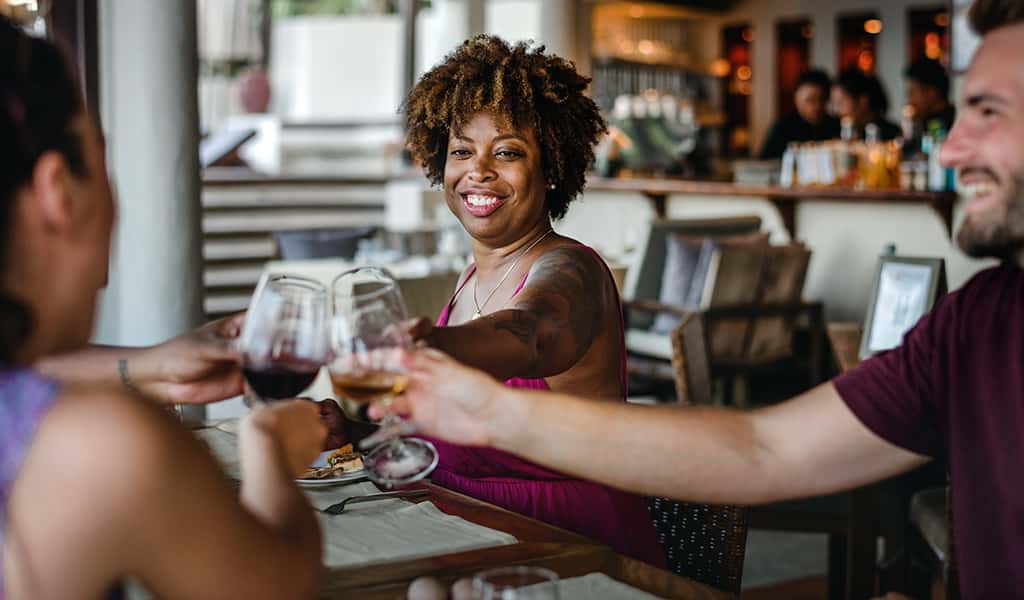
With Canadians dining at restaurants frequently, what is causing Canadians to choose specific restaurants? Caddle set out to determine this in a recent survey, and 39% of respondents cited word of mouth as their top reason. Coupons came in second at 14%, menu options at 13%, online reviews and social media tied at 12% each, then a big drop to newspaper/magazine articles at 3%. What may come as the biggest surprise is that 0% of respondents credited online ads as a prompt to try a new restaurant.
This doesn’t necessarily mean that restaurants should cancel any paid placements – there are good reasons to remain open to advertising and various ways to achieve effective ads. Paid endorsements by social media influencers, Google AdWords to improve your visibility in search, boosted posts on relevant platforms such as Instagram – there are many avenues to consider and explore, regardless of budget.

However, what this research does reveal to restaurants is that above all else – what matters most is the quality of what you’re serving and how you serve it (i.e., customer service). Four of the top five reasons why Canadians choose a certain restaurant revolve around these factors. If you provide a memorable meal and impeccable service, diners are more likely to recommend you to family and friends, potentially leave a positive review, and brag about trying your food to their followers.
